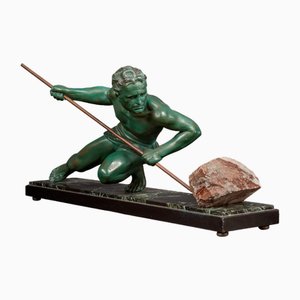Artistic explanation:
The Nymph Taking Her Bath is a masterful work of 18th-century French sculpture, created by Étienne-Maurice Falconet in 1757. This bronze statue depicts a nude young woman in a graceful and natural posture, captured in an intimate moment while she enters her bath.
Posture and expression:
• The nymph is depicted in a natural, flowing pose, leaning slightly forward, as if she were picking up or laying down a cloth. This posture highlights the elegant curves and anatomical details of the female body, paying homage to natural beauty and grace.
• Details and textures: The texture of the drapery and the subtle details of the hair and skin are beautifully rendered, demonstrating Falconet's mastery in the treatment of bronze. The play of light on the polished surface of the bronze adds a lively and realistic dimension to the sculpture.
• Symbolism: The choice to represent a nymph, a mythological figure often associated with nature and water, reflects the influence of classical and mythological themes in 18th century art. This speaks to the era's interest in antiquity and ideals of classical beauty.
Historical context :
• Period: The sculpture was made in 1757, a period when Rococo art was booming in France. This style is characterized by its elegance, refinement and penchant for graceful and delicate subjects.
• Style: Although Falconet is often associated with Rococo, this work shows a transition to a more neoclassical style, with a simplicity and purity of form that heralds future artistic trends.
• Sponsor: The work was commissioned by the financier and collector Ange Laurent Lalive de Jully, which shows the interest of the elites of the time in classical art and culture.
Explanations on the founder:
The exceptional quality of the casting of this sculpture is the result of the work of an expert bronze caster. At this time, founders often worked closely with sculptors to create high-quality pieces. Renowned founders of this period included workshops such as those of Jean-Baptiste Claude Odiot or the Keller brothers, although specific documentation on the founder of this work is not always available.
Museum references:
Copies of The Nymph Taking Her Bath can be found in several prestigious museums, including:
• The Louvre Museum in Paris, which has a rich collection of 18th-century French sculptures.
• The Museum of Fine Arts of Lyon, where you can also admire other works by Falconet and his contemporaries.
• The HERMITAGE museum in SINT PETERSBURG.
Symbolism of the work:
The Nymph taking her bath symbolizes both the ideals of beauty and purity, the intimate relationship between humans and nature, and stylistic transitions in 18th century art. It embodies the decorative and elegant elements of Rococo while anticipating the simplicity and grandeur of Neoclassicism. The nymph represents the ideal of feminine beauty in the classical tradition, purity and innocence, as well as the connection to nature and mythological elements.
Link with Madame de Pompadour's daughter:
It is interesting to note that Falconet was supported by Madame de Pompadour, the mistress of Louis XV and a great patron of the arts. Madame de Pompadour's daughter, Alexandrine Le Normant d'Étiolles, died young, and Falconet may have found some inspiration in the youth and beauty of this child, as well as in the influence of his mother, to create works imbued with grace and tenderness.
Biography of Étienne-Maurice Falconet:
Étienne-Maurice Falconet (1716-1791) was a French sculptor famous for his refined and elegant works. He trained at the Royal Academy of Painting and Sculpture and worked under the direction of the famous sculptor Jean-Baptiste Lemoyne. Falconet quickly gained notoriety for his graceful sculptures and portraits.
• Career: In 1757, Falconet was appointed director of the sculpture workshop at the Manufacture de Sèvres, where he influenced many young artists. In 1766, he was invited by Catherine II of Russia to work at the imperial court in St. Petersburg, where he created his most famous work, The Bronze Horseman, a monumental equestrian statue of Peter the Great.
• Style and influence: Falconet was a pioneer in the transition from rococo to neoclassicism, combining decorative elegance and classical simplicity. His work had a lasting influence on European sculpture.
In summary, The Nymph Taking Her Bath is an iconic work that perfectly illustrates Falconet's talent and artistic vision, while reflecting the tastes and artistic trends of his time.




















Get in Touch
Make An Offer
We noticed you are new to Pamono!
Please accept the Terms & Conditions and Privacy Policy
Get in Touch
Make An Offer
Almost There!
To follow your conversation on the platform, please complete the registration. To proceed with your offer on the platform, please complete the registration.Successful
Thanks for your inquiry, someone from our team will be in touch shortly
If you are a Design Professional, please apply here to get the benefits of the Pamono Trade Program